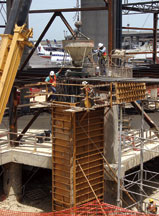 |
| BUILDING UP Airports such as Dallas-Fort Worth are expanding. (Photo courtesy of DFW) |
U.S. air passenger traffic overall has not yet recovered to the levels seen before the Sept.11, 2001, terrorist attacks, but it is getting there. At several airports, even capacity crunches have reappeared. Airport expansion and improvement plans had been shelved nationwide, but now they are coming back off the shelf, says Gerald FitzGerald, Parsons Brinckerhoff Inc.s aviation industry director.
Several factors are at work. I think its the combination of more comfort with security, some airline stabilization, low-cost carriers continuing to take their market share or more, [and] the economys a little better, says Michael Steer, URS director of aviation.
Steer and other industry specialists also believe that the airlines shift to smaller regional jets from larger aircraft is putting more pressure on airports. Regional jets have 50 to 100 seats, compared with 150 to 250 on larger aircraft. Air carriers tend to schedule more takeoffs and landings for their regional jets than for the larger planes in their fleets. That means more wheels rolling on the runways and more strain on airport pavements.
While passenger volume is below pre-9/11 levels, the operations at the airports have increased and thats significant in terms of wear and tear on the air-traffic control facilities, the infrastructures, the airport terminals, all of that, says Todd Hauptli, senior vice president with the Airports Council International-North America and American Association of Airport Executives. At OHare in Chicago, regional jets are like a swarm of bees coming to the hive, he says. FitzGerald adds: The good news is that the regional jets usually have faster turnaround time than bigger jets, [but] they still need extra runway and taxiway capacity.
| RELATED LINKS |
 After Setbacks, Airport Traffic and Work Is Moving Over Miami After Setbacks, Airport Traffic and Work Is Moving Over Miami
|
 Dallas-Fort Worth Speeds Passengers From Trains to Planes Dallas-Fort Worth Speeds Passengers From Trains to Planes
|
To help pay for some of that infrastructure, particularly airside projects such as runways and taxiways, airports are taking advantage of the Vision 100 aviation law enacted last December. Among other things, that federal statute increases funding for FAAs Airport Improvement Program grants, modestly at first, from $3.38 billion in 2003 to $3.4 billion this year. But starting in 2005, the measure boosts AIP aid a further $100 million annually to a peak of $3.7 billion in 2007.
Another piece thats very helpful is what Vision 100 did on the project streamlining elements...with an eye toward reducing the time it takes to go through the review and approval process for major construction projects, says Hauptli.
After 9/11, a greater share of AIP funds went for security projects, reducing the money available for runways and taxiways. To counter that drain, Vision 100...
|

Post a comment to this article
Report Abusive Comment